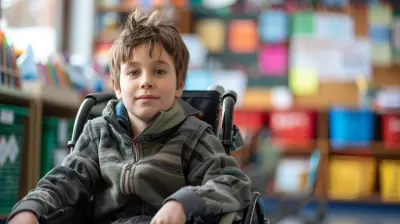The Benefits of Mindfulness Practices for Students
17 August 2025
Let’s be honest—being a student today is tough. Between the constant stream of assignments, social expectations, exams, extracurriculars, and worries about the future, it’s no wonder students feel overwhelmed. We live in a world that doesn’t hit the pause button, and for students especially, the pressure can feel never-ending.
That’s where mindfulness steps in like a breath of fresh air.
Mindfulness isn’t some mystical or complicated practice—it’s really just about being present. And for students juggling so much, it can be the secret weapon to not only surviving but actually thriving in and out of the classroom.
So, what’s the big deal about mindfulness? Why is everyone talking about it, especially in education? Let’s break it down and see how a few mindful moments a day can create powerful change.
What Is Mindfulness, Really?
Before we dive into the benefits, let’s quickly unpack what mindfulness means. At its core, mindfulness is simply being fully present and engaged in the moment—without judgment. You’re not stuck in the past or worrying about the future. You’re just here, now.Think of it like tuning in to the present moment like you'd tune a radio to the right station. You're focused, clear, and not distracted by all the static noise life throws at you.
Mindfulness practices can include things like:
- Deep breathing
- Guided meditation
- Body scans
- Mindful walking
- Even simple practices like fully focusing on eating or listening
It’s not about emptying your brain or becoming a Zen master overnight. It’s about noticing your thoughts without letting them rule you.
Why Should Students Even Care About Mindfulness?
That’s a fair question. Between classes and catching up on sleep (or trying to), adding “mindfulness” to the to-do list might sound like a chore. But here’s the thing—it isn’t about adding more. It’s about creating space.Here’s where mindfulness can make a real difference:
- It helps students manage stress better.
- It improves concentration and focus.
- It boosts emotional regulation.
- It supports mental health.
- It encourages better sleep habits.
- It strengthens relationships with peers and teachers.
Let’s dig into some of these more deeply.
1. Stress Reduction: The Calm in the Chaos
Stress is basically a student’s shadow—it follows everywhere. Whether it’s preparing for exams or figuring out group projects, stress is a regular visitor.But mindfulness offers a way to turn down the mental noise. By practicing breathing exercises or even two-minute meditations, students can train their minds to step back from the chaos.
Studies show that mindfulness lowers cortisol levels—the hormone responsible for stress. It doesn’t erase problems, but it helps students respond to them with a clearer, calmer mind. Imagine facing a tough test not with panic, but with poise. That’s the power of a mindful pause.
2. Enhanced Focus and Academic Performance
Ever sit down to study and suddenly remember everything else you'd rather do? (Clean your room, scroll your feed, stare at the ceiling...)Mindfulness fights that scattered brain feeling. It’s like giving your attention a workout. A consistent mindfulness practice helps students build stronger concentration skills, making it easier to focus during lessons, retain information, and reduce mind-wandering during study sessions.
And guess what? Better focus = better grades. It’s all connected.
3. Boosted Emotional Regulation
High school and college can be emotional roller coasters. From feeling left out to managing failures or navigating tough conversations, emotions run high.Mindfulness helps students observe their feelings rather than getting pulled under by them. Instead of exploding in anger or sinking into sadness, they learn to recognize emotions for what they are—temporary and manageable.
This emotional regulation builds emotional intelligence—a life skill that helps way beyond the classroom.
4. Improved Physical Health
Here’s a bonus: mindfulness doesn’t just help the mind—it helps the body, too.Practicing mindfulness can lead to:
- Better sleep
- Lower blood pressure
- Strengthened immunity
- Reduced fatigue
It’s like giving your body a reset button. Better sleep alone can transform a student’s ability to function and feel energized throughout the day.
5. Strengthened Peer and Teacher Relationships
Ever had a bad day and taken it out on a classmate or teacher? (We’ve all been there.)Mindfulness teaches empathy and patience. By being present and grounded, students become better listeners and more thoughtful communicators.
This leads to better collaboration on group projects, less conflict with peers, and stronger, more respectful relationships with teachers. When students are more mindful, classrooms become kinder, safer, and more inclusive spaces.
6. Reduced Test Anxiety and Increased Confidence
Test anxiety is real—and paralyzing. Even when students know the material, nerves can wreck their performance.Enter mindfulness.
Mindful breathing or visualizations before a test can calm the nervous system and bring students into a state of focused readiness. It helps students ground themselves so the anxiety doesn’t hijack their brain.
Over time, mindfulness builds a sense of confidence. Students start to realize they can handle pressure with calmness and courage.
7. Encourages Self-Awareness and Personal Growth
Mindfulness invites students to check in with themselves—mentally, emotionally, even spiritually.That self-awareness is powerful. It helps students:
- Notice harmful habits
- Recognize when they need help
- Set better goals
- Understand their strengths and weaknesses
It's like handing students a mental mirror and saying, “Here’s who you are. Now, how do you want to grow?”
8. Fosters Resilience
Life throws curveballs. For students, setbacks can feel bigger and harder to bounce back from—whether it’s a failed test, a rejection letter, or a personal challenge.Mindfulness nurtures resilience by teaching that setbacks are not the end of the world. They’re just experiences—lessons along the way.
With a mindful approach, students can reframe failures and stay grounded through adversity. That mental strength? It’s something they'll carry for life.
Easy Mindfulness Practices Students Can Start Today
Now that we’ve hyped it up, let’s get practical. Mindfulness doesn’t require hours of meditation or fancy yoga mats. Here are simple, realistic ideas students can weave into daily life:1. Two-Minute Breathing Breaks
Close your eyes. Inhale slowly for 4 seconds, hold for 4, exhale for 6. Repeat for 2 minutes. That’s it. It's a reset button anytime, anywhere.2. Mindful Mornings
Start the day without phones. Sit quietly for 5 minutes, do a gratitude check, or stretch. It sets a calm tone before the hustle.3. Body Scan During Study Breaks
Take a short break, lie down or sit back. Focus your attention on each part of your body starting from your toes to your head. Notice sensations without judgment.4. Mindful Eating
No phones, no rushing. Just you and your meal. Taste the food, chew slowly, and focus on the moment.5. Journaling
Write down whatever’s on your mind. It’s a powerful way to process thoughts and emotions.6. Free Apps and Resources
Apps like Headspace, Calm, and Insight Timer offer free guided meditations. Great for beginners!Supporting Mindfulness in Schools
It’s not just up to students. Teachers, counselors, and schools play a huge role in creating a culture of mindfulness.Some schools are already building in time for:
- Morning mindfulness routines
- “Brain breaks” during class
- Meditation minutes before exams
- Counseling sessions that integrate mindful practices
These small changes don’t cut into learning time—they enhance it.
Final Thoughts: It’s the Little Things That Make a Big Difference
Mindfulness isn’t magic. It’s not going to make exams disappear or turn every day into sunshine and rainbows. But what it does offer is a steady ground. A way to hit pause, breathe, and remember—you’ve got this.For students feeling stuck, stressed, or just out of sync, mindfulness is like a quiet friend sitting next to you reminding you, “You’re okay. You’re capable. You’re present.”
In a world that’s constantly pushing for more, mindfulness gently invites us to be still. And sometimes, that’s exactly what we need.
all images in this post were generated using AI tools
Category:
Student SuccessAuthor:

Bethany Hudson
Discussion
rate this article
1 comments
Nym Rodriguez
Mindfulness practices can profoundly enhance students' mental well-being, focus, and resilience. By integrating techniques such as meditation and deep breathing, students can improve stress management, boost academic performance, and foster a more positive school environment.
September 10, 2025 at 3:30 AM

Bethany Hudson
Thank you for your insightful comment! I completely agree—mindfulness practices are invaluable tools for enhancing students' overall well-being and academic success.


